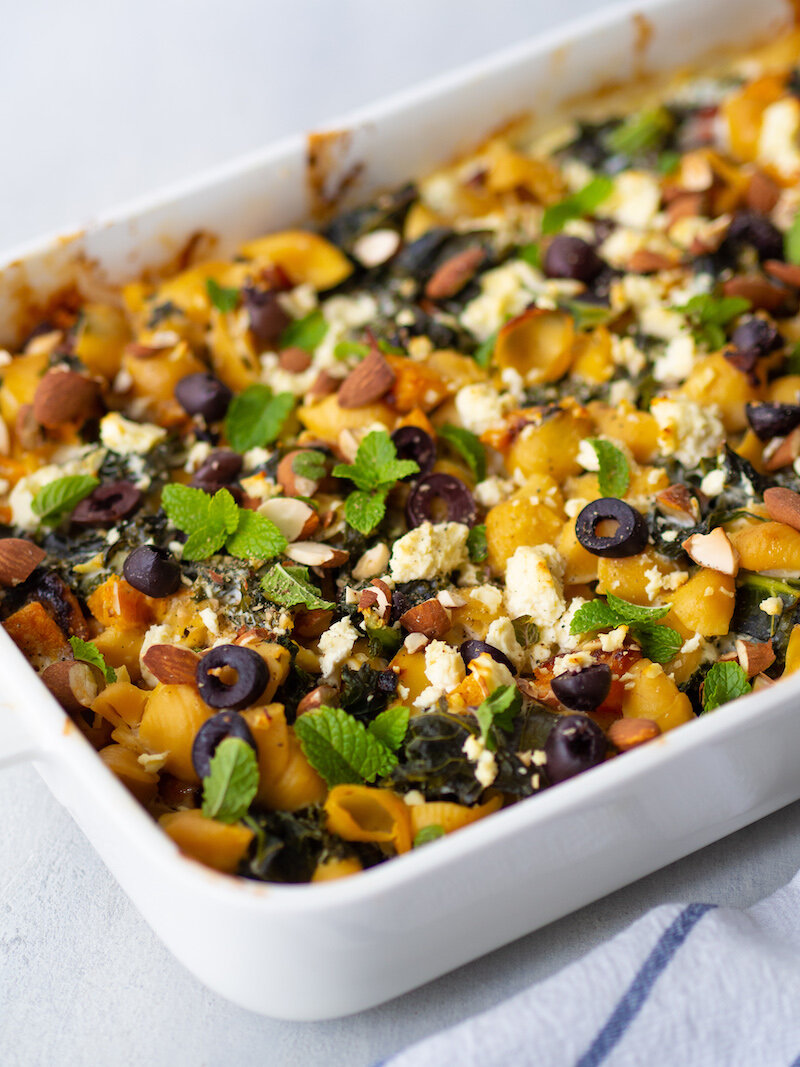Vegetarian Pasta Casserole with Butternut Squash and Kale Recipe
Who can say no to a creamy pasta casserole dish? This vegetarian pasta casserole recipe is packed with vegetables, Mediterranean flavors such as feta cheese, olives, and topped with a creamy Greek yogurt sauce.
Who doesn’t love a good pasta casserole? For one, pasta is hard to mess up, and two, casseroles are so easy to prepare! The “hardest” part about this dish is simply waiting for the water to boil before cooking the pasta. Ok that may be exaggerating a bit, but in all seriousness, all you have to do to make this recipe is roast vegetables, toss it with cooked pasta and easy 3-ingredient sauce, and pop it in the oven until golden!
Aside from how easy and convenient it is, one of my favorite things about this vegetarian pasta casserole is that it works great for meal prepping! The pasta casserole can be prepared and baked over the weekend for a microwave dinner on a busy night. Also, you could double up and make two batches, bake one, and then freeze the other to bake for another time. That way all you have to do is remove the prepped casserole from the freezer and bake it in a pre-heated oven.
This dish is great for a pot-luck style gathering as it can be used as either a main or a side dish. For people with celiac disease or gluten sensitivities, you can swap out the whole grain pasta to a lentil pasta, chickpea pasta, or brown rice pasta.
There are many ways to throw your own twist to this vegetarian pasta casserole recipe. One is by making it non-vegetarian and adding a meat, such as shredded chicken or even sausage. Feel free to switch up the vegetables. Instead of butternut squash, use another squash like zucchini or summer squash, or use a different vegetable entirely like broccoli.
This vegetarian pasta casserole recipe also contains a variety of nutrients that are beneficial for your health! Here are a few:
Whole grains: Whole grains refer to a grain product that contains the entire grain including the bran, endosperm, and germ. It’s important to eat products that are whole grain because each part of the grain contain different nutrients. The outer layer of the grain is the bran which is rich in fiber and B vitamins. The endosperm is the inner layer and is rich in protein and carbohydrates. The germ is the core of the grain and contains vitamin E, and more B vitamins. This is just a snapshot of all the benefits from eating whole grains!
Leafy greens: Citrus fruit is probably what comes to mind when you think of vitamin C, but green leafies are a pretty good source too. Green leafy vegetables have also been shown to help lymphocytes, a type of immune cell, function properly. In addition to vitamin C, kale also contains ANOTHER antioxidant, vitamin A. Antioxidants help reduce the free radicals in your body by donating an electron, to make them balanced or “happy”. This is a good thing because a buildup of free radicals causes more oxidative stress and more damage to your body’s cells.
Lemon zest: Lemon peel containsw vitamin C and may have antimicrobial and anti-fungal properties. This study examines the reduction of growth of an antibiotic-resistant bacteria using citrus water extracts containing lemon peel.
Garlic: Garlic has been used medicinally for years to treat everything from gangrene to the plague. Would not recommend that! However, there's actual scientific evidence showing garlic's benefits for colds. One study found people who take garlic supplements were less likely to catch a cold, and those who did actually recovered faster. The active ingredient in garlic is called S-allyl cysteine and it has anti-inflammatory, neuroprotective, and nootropic potential — in other words, great for your body and mind!
Almonds: Almonds, in fact, are one of the world’s best sources for vitamin E! Just one ounce of almonds contains 37% of the recommended dietary intake (RDI) for vitamin E, 32% of the RDI for manganese, and 20% of the RDI for magnesium. They are a great snack that will provide your body with nutrients including important fats and protein to fuel your body throughout the day.
Feta Cheese: Feta cheese is a staple in Greek foods and it’s quite nutritious! Just one ounce of feta cheese contains 14% of your daily needs of riboflavin (a B vitamin) and calcium. B vitamins play a role in creating energy for your body. Calcium is needed to build and maintain good bone health.
Greek yogurt: Greek yogurt has become very popular over the years. What makes it different from regular yogurt is that Greek yogurt is strained, removing some of the liquid and making a yogurt with a thicker texture. This gives it a tart taste, and a rich texture with more carbohydrates and protein. Greek yogurt also contains probiotics that are helpful for digestion.
Using Greek Yogurt in Cooking
If you think Greek yogurt is just for snacking, you might be weirded out by using it as a sauce in this vegetarian pasta casserole recipe, but it’s actually quite versatile. Greek yogurt is a great ingredient to use in all kinds of recipes like pasta sauce, marinades, and soups. It adds a creamy texture and tangy flavor. It can be a great substitute for mayonnaise, sour cream, or even heavy cream if you’re looking for a less dense texture but still want a creamy component. I recommend using full fat Greek yogurt as opposed to fat free for the best flavor and texture. Non-fat Greek yogurt often contains stabilizers or fillers that may alter the taste and texture of a recipe. Swapping out Greek yogurt also adds extra protein which is great for vegetarian dishes like this pasta casserole!
Vegetarian Pasta Casserole with Butternut Squash and Kale Recipe
Serves 4
Adapted from 101 Cookbooks
Ingredients
Zest of 1 lemon
8 ounces whole grain pasta (I used Banza shells)
1 1/2 cups winter squash, in 1/2 inch cubes
Olive oil, for roasting the squash
1 bunch of kale, spinach or chard, thick stems removed and cut into ribbons
2 cups whole or 2% plain Greek yogurt
1 egg
3 cloves garlic, minced
1/2 teaspoon salt, 1/4 teaspoon black pepper
2/3 cup toasted almonds
1/4 cup kalamata olives, roughly chopped
1/3 cup crumbled feta cheese
Chopped fresh mint, for serving
Instructions
Preheat oven to 400 degrees.
Toss squash with olive oil. Season with salt and black pepper. Spread evenly on a large baking sheet and roast for about 20 minutes, until tender and caramelized.
Meanwhile, rub an 8 x 12 inch baking dish with olive oil. Sprinkle evenly with lemon zest and set aside.
Cook the pasta in boiling water until al dente. A few minutes before you stop cooking the pasta, add the kale. Drain and run through cold water to stop the cooking process.
While the pasta cooks, mix the yogurt, eggs, garlic, salt and black pepper in a large mixing bowl.
Toss the pasta-kale mixture and roasted squash with the yogurt sauce and half the almonds. Spread evenly in the baking dish. Top with olives and feta cheese.
Bake for 25-30 minutes until golden and bubbly. Remove from oven and sprinkle fresh mint and remaining almonds over the top.






